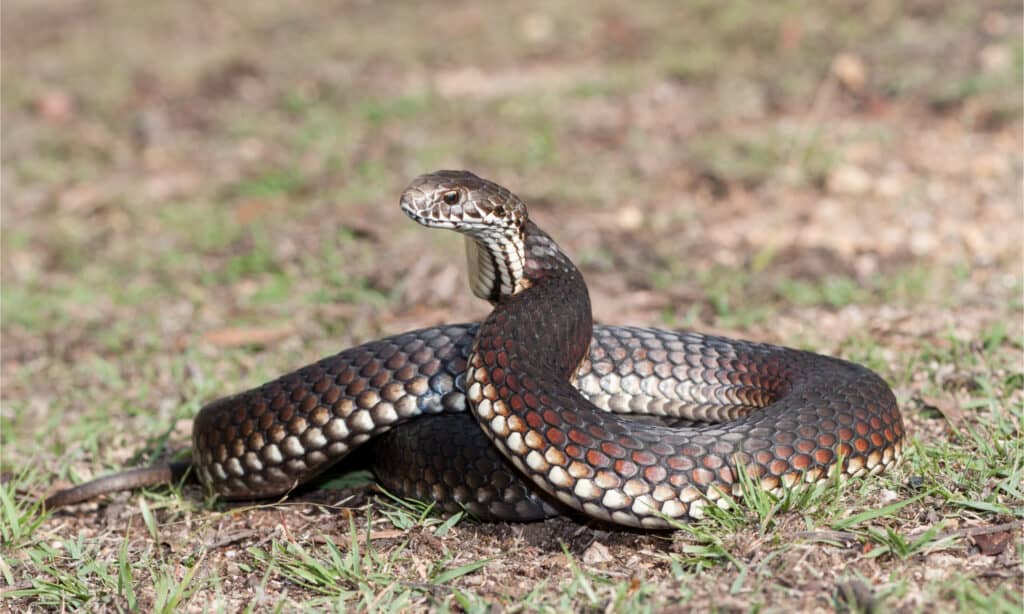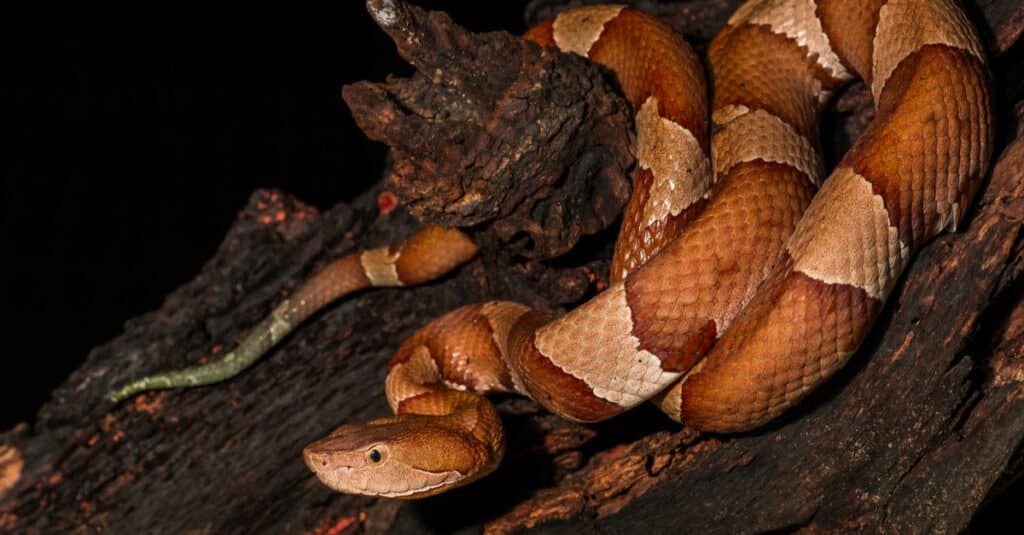Eastern copperheads (Agkistrodon contortrix) are common venomous snakes found in the southern and eastern United States. They’re pit vipers in the same genus as cottonmouth snakes (Agkistrodon piscivorus), but their behavior is quite different. For starters, copperhead snakes are usually more docile than cottonmouths and not as quick to bite. They are also social in the winter and commonly brumate with other snakes, and copperhead snakes prefer dryer habitats than the semi-aquatic cottonmouth snakes.
Key Facts
- Copperhead snakes hibernate (brumate) between October and late March or early April in North Carolina.
- These are social snakes and den together to share warmth.
- Copperhead snakes give birth to 3-14 live babies during late summer and early fall.
- They may venture out from their dens to warm up on sunny days, even in the middle of winter.
What is a Copperhead Snake?

Juvenile copperheads have bright yellow tails, unlike cottonmouths with bright green tails.
©Creeping Things/Shutterstock.com
A copperhead snake is a venomous pit viper that inhabits the southern and eastern United States, but they only venture into the panhandle of Florida. Their range includes the areas from Texas and northern Mexico to Georgia, the Carolinas, and north to New England.
This species is nocturnal and most active during the evening hours during the heat of the summer. However, they may also be active in the spring and fall when daytime temperatures are slightly cooler.
During the spring, copperheads are often seen hiding among piles of leaves, but males have been photographed in the middle of wildflower fields, wrestling for breeding rights. By the end of the summer, females that mated that spring have begun giving birth. Juvenile copperheads have bright yellow tails, unlike cottonmouths with bright green tails. They’re often found in multiples because they stay near their mother for the first few days after birth.
Later in the fall, the snakes move off toward brumation dens.
What is Hibernation or Brumation?
Hibernation is what warm-blooded animals do to survive the winter without dealing with scarce resources. Animals that hibernate fatten themselves up during the spring and summer, then sleep through the lean winter months. They do not eat or drink during this period and often stay in their dens until spring.
While the term gets used to apply to all animals that slumber through cold weather, it’s not exactly accurate for reptiles and amphibians. Reptiles and amphibians do something called brumate, the reptilian answer to hibernation. Like warm-blooded hibernating animals, cold-blooded animals try to fatten up during the summer. However, unlike hibernating animals, reptiles and amphibians do not enter a state of deep sleep. They simply become very sluggish and don’t eat.
Most of these animals are still awake and can react to external stimuli. Venomous snakes in brumation can still bite and are still dangerous.
Brumating reptiles and amphibians sometimes leave their dens to bask on a sunny day or get a drink of water, but they don’t eat. If they ate when they didn’t have the sun’s warmth to increase their core temperature, their food would likely sit in their stomachs and rot, making them sick or killing them.
There’s another difference between hibernation and brumation: mammals still require a certain amount of oxygen, but snakes can tolerate far less oxygen than mammals.
What Triggers Hibernation (Brumation) in Copperheads?

Most
North American
snakes become sluggish when the mercury dips below 60℉, and copperheads are no exception.
©Ken Griffiths/Shutterstock.com
Just like warm-blooded animals, snakes eat as much as possible during the spring and summer. Then, when the days get shorter, and the weather begins to cool off, copperheads make the journey back to their den.
Most North American snakes become sluggish when the mercury dips below 60℉, and copperheads are no exception. This, and shorter daylight hours, combine to trigger brumation for these snakes. Juveniles born during the fall don’t always make it to their winter dens in time to settle in with the others. Their first winter is often the hardest, and many newly-born snakes don’t survive.
Where do Copperhead Snakes Hibernate (Brumate)?
Snakes brumate together in dens that can be as simple as a pile of brush or an elaborate set of cliffside caves with a series of interconnected chambers. In general, copperheads prefer places with some type of forest habitat available. They’re fairly flexible in where they can live, but regardless of the specific region, they are happy almost anywhere with sunlight and cover.
Copperheads are surprisingly social snakes during the winter. These snakes love to tuck themselves into rock crevices and often share dens with many other snakes. It’s common to find copperheads of both sexes, and all ages in the same den — even snakes of other species are found sharing space and body heat.
Even though they share space during hibernation (brumation), they spend most of their time alone. Yet, most individuals will never travel more than a mile or two away from their preferred hibernacula. In general, copperheads prefer areas close to hills with lots of rocks and debris and access to sunlight to warm themselves. Their dens are often near the edges of rivers, ponds, or other water sources. However, they don’t always stay in their dens throughout winter. They sometimes leave their dens on sunny days to warm up and get a drink before returning to the den.
How Long Do Copperhead Snakes Hibernate (Brumate)?

Copperheads that live higher in the mountains where the weather cools earlier in the year may brumate for longer periods.
©Wildvet/Shutterstock.com
Most snakes that need to hibernate or brumate begin when the daytime temperatures fall far enough to stall their digestive processes — which for most in North America occurs below about 60℉. They emerge in the spring when they can obtain enough warmth from the sun.
The copperhead snakes in North Carolina hibernate (brumate) from about October through late March or early April. Of course, this is only an estimate. Snakes respond to the environmental cues that tell them when it’s time to tuck themselves into a den and when they should emerge in the spring. This can vary from year to year, depending upon the conditions in the local area. For example, copperheads living higher in the mountains where the weather cools earlier in the year may brumate for longer than their coastal cousins.
Up Next:
- Do cottonmouth snakes hibernate in Florida?
- How to identify a copperhead
- Copperhead vs. rattlesnake: 5 key differences
- Copperhead snakebite: how deadly are they?
The photo featured at the top of this post is © Daulton Moore/Shutterstock.com
Discover the "Monster" Snake 5X Bigger than an Anaconda
Every day A-Z Animals sends out some of the most incredible facts in the world from our free newsletter. Want to discover the 10 most beautiful snakes in the world, a "snake island" where you're never more than 3 feet from danger, or a "monster" snake 5X larger than an anaconda? Then sign up right now and you'll start receiving our daily newsletter absolutely free.
Thank you for reading! Have some feedback for us? Contact the AZ Animals editorial team.






